Spectroscopy: Miniature all-passive FTIR spectrometer fits on mobile phones
Optical spectroscopy can potentially provide a wealth of information useful for daily life, from how fresh fruits and vegetables are at the market to how much blue light (which can hinder sleepiness at night) is in a white-light LED, to cosmetics matching and wine color evaluation. However, conventional spectrometers are costly and confusing for the nonspecialist to use.
Aiming to change this situation, a technical team at FrinGOe (Singapore) has developed and is commercializing a scientific-grade Fourier-transform infrared (FTIR)-based add-on spectrometer that can be easily adapted for use with a mobile phone or a Raspberry Pi camera. A prototype has already been developed that takes the form of a case for an iPhone 5S; the device is a passive add-on (meaning no electrical connections needed).
Conventional grating-based spectrometers are limited in how small they can be made due to the requirement of a minimum dispersion length; in addition, conventional FTIR spectrometers contain a moving mechanical spectral-scanning element. To develop a low-cost, all-passive, and compact FTIR device that can be easily attached to a mobile-phone camera, the FrinGOe engineers replace the conventional mechanically scanned Michelson FTIR interferometer with an array of nonscanned Mach-Zehnder (M-Z) interferometers, each with its own detector and a different value for path difference, fabricated in a 2D array in an optical crystal.
Such a configuration requires M-Z interferometers with large path differences for high resolution, and numerous individual interferometers and detectors to handle the large maximum path difference. For example, a spectral resolution of 1 nm at a 400 nm wavelength requires more than 800 detectors. For the FrinGOe spectrometer in an iPhone configuration, each detector consists of on the order of one row of pixels in the phone’s camera detector array. This is no problem for modern mobile phones, which have array sizes of 3000 × 2000 pixels or more.
Many spectra at once for low noise
In an example acquisition by a phone camera with 3264 × 2448 pixels (8 Mpixels), each row of the sensor array is used to produce a 3264-point interferogram, and 2448 interferograms are captured in one snapshot. Although the Fourier transform of one interferogram is sufficient to produce the spectrum, a Fourier transform is applied on each of the 2448 interferograms to obtain 2448 spectra for averaging, which produces a final spectrum with extremely low noise. This is equivalent to performing 2448 repeated scans of a conventional FTIR spectrometer for spectrum averaging.
A spectral scan of a modern fluorescent lamp by the FrinGOe device shows the expected spectral line at 546 nm produced by the mercury in the lamp, as well as other spectral peaks produced by the lamp’s phosphors (see figure).
FrinGOe’s M-Z crystal array is relatively insensitive to temperature changes and to mechanical misalignments, say the company’s engineers. This allows the device, when mounted on a mobile phone, to be adjustable between an operational position where it is positioned in front of the camera, to a nonoperational position where the camera can function normally.
“We believe that equipping the man on the street with a convenient, versatile and low-cost scientific-grade spectrometer will revolutionize the way humans communicate light and colors and explore the world around us,” says Andy Low, one of the company’s engineers. “In addition, an affordable spectrometer designed for the Raspberry Pi can also be a great educational tool to teach students about the spectrum of light and may find many uses in different areas. By proliferating the spectrometer technology to the masses, crowdsourcing of data can now be realized and previously undiscovered trends/signatures may be observed.”
FrinGOe is working with manufacturers interested in integrating the device as an OEM spectrometer into their products, says Low. In addition, the company is collaborating with industry authorities (such as those in the printing, display, paint, cosmetic, and other colorimetry-related industries) to develop customized software apps to correlate FrinGOe’s spectroscopic information to their industrial color standards.
A software development kit will be made available early next year to individuals or companies who are interested in developing new spectroscopic-related apps based on their specific niche and interest.
About the Author
John Wallace
Senior Technical Editor (1998-2022)
John Wallace was with Laser Focus World for nearly 25 years, retiring in late June 2022. He obtained a bachelor's degree in mechanical engineering and physics at Rutgers University and a master's in optical engineering at the University of Rochester. Before becoming an editor, John worked as an engineer at RCA, Exxon, Eastman Kodak, and GCA Corporation.

